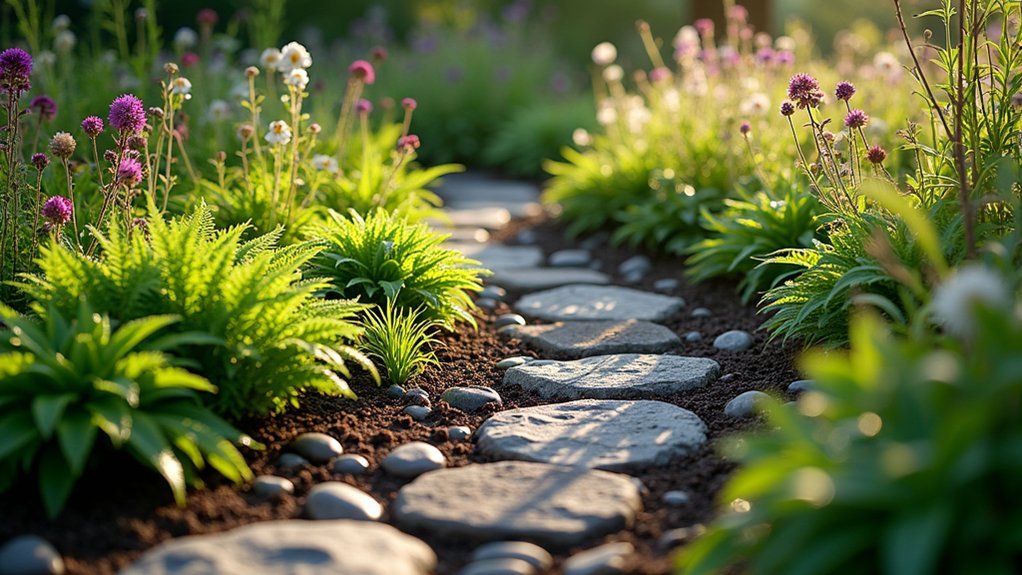Three effective borders for rain garden erosion control include rock-lined edges, native plant borders, and deep-rooted grasses and sedges. Rock edges create stabilized perimeters that slow water flow during heavy rains. Native plants with extensive root systems prevent soil washout while supporting local biodiversity. Deep-rooted grasses like Switch Grass enhance absorption and soil structure. These natural solutions work together to protect your garden investment while creating habitat corridors for beneficial wildlife.
Rock-Lined Rain Garden Edges for Sloped Landscapes

When tackling erosion on sloped properties, rock-lined rain garden edges offer a sturdy, practical solution that combines form with function. These strategic borders create a physical barrier that prevents soil erosion while enhancing water absorption into your garden basin.
Rock-lined edges create natural barriers that fight erosion while maximizing water retention where it’s needed most.
For maximum effectiveness on sloped landscapes, arrange larger rocks at the bottom and smaller stones toward the top. This graduated structure slows water flow during heavy rain, allowing for better infiltration and reduced runoff. Using native stone materials not only complements your surrounding landscape but guarantees ecological compatibility.
Your rock-lined edges will effectively direct overflow water into the rain garden basin rather than allowing it to damage adjacent areas.
Don’t forget that regular maintenance is essential—remove debris and check for displaced stones to maintain ideal erosion control and drainage performance.
Native Plant Borders That Strengthen Rain Garden Perimeters
The strategic placement of native plants around your rain garden perimeter creates a living barrier that combats erosion far more effectively than hardscaping alone. By selecting species with deep-root systems, you’ll establish natural soil stability while enhancing local biodiversity.
| Plant Type | Benefits | Recommended Species |
|---|---|---|
| Shrubs | Dense coverage, year-round protection | Red-Osier Dogwood, Sweetspire |
| Grasses | Fast establishment, excellent water absorption | Switch Grass, Indian Grass |
| Flowering Perennials | Attracts pollinators, beautifies borders | Daylilies, Catmint |
| Layered Combinations | Multi-level erosion control | Aronia with understory plants |
| Deep-Rooted Species | Maximum soil stabilization | Prairie plants, native sedges |
You’ll find these native plant borders not only prevent soil washout during heavy rains but also create habitat corridors that connect your rain garden to the broader ecosystem, supporting wildlife while protecting your investment.
Deep-Rooted Grasses and Sedges for Rain Garden Stability

Beneath the surface of a successful rain garden lies an intricate network of roots that forms nature’s own erosion control system.
When you incorporate deep-rooted grasses like Panicum virgatum and sedges such as Carex species, you’re installing natural anchors that greatly enhance soil stability.
These native species do more than prevent erosion—they improve water infiltration, allowing your rain garden to efficiently manage stormwater runoff.
Their fibrous root structures enrich the soil with organic matter while fostering beneficial microbial activity.
You’ll appreciate that these plants are drought-tolerant once established, requiring minimal maintenance while performing maximum work.
Frequently Asked Questions
Do Rain Gardens Help With Erosion?
Yes, rain gardens help with erosion considerably. You’ll find they slow stormwater runoff, allow water infiltration, and their deep-rooted native plants stabilize soil effectively. They’re excellent for managing excess water during heavy rainfall.
How Do You Edge a Rain Garden?
You’ll want to edge your rain garden using natural materials like stones or logs. Create a slightly raised border that directs water inward. Don’t forget to incorporate native plants along edges to stabilize soil.
What Is the Best Ground Cover for Erosion Control?
For erosion control, you’ll find creeping juniper and native red-osier dogwood most effective due to their robust root systems. Don’t overlook stonecrop for dry areas—it’s drought-tolerant while still preventing soil runoff effectively.
What Are the Disadvantages of a Rain Garden?
You’ll face significant costs ($4-$30 per square foot), ongoing maintenance requirements, potential drainage problems, ineffectiveness in clay soils or high water tables, and possible plant damage from deer if you install a rain garden.
In Summary
Installing rock-lined edges, native plant borders, or deep-rooted grasses around your rain garden isn’t just aesthetically pleasing—it’s smart engineering. You’ll prevent erosion, stabilize slopes, and create habitat simultaneously. These natural solutions work with the environment rather than against it. As you maintain your borders, you’ll notice improved water infiltration and reduced runoff, making your property more resilient with each rainfall.





Leave a Reply